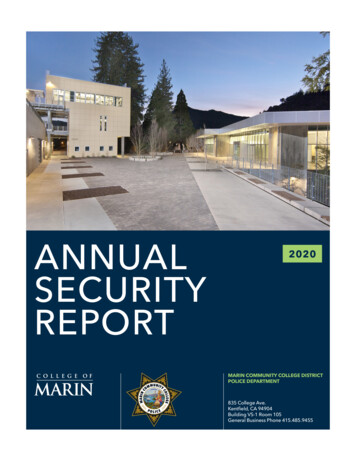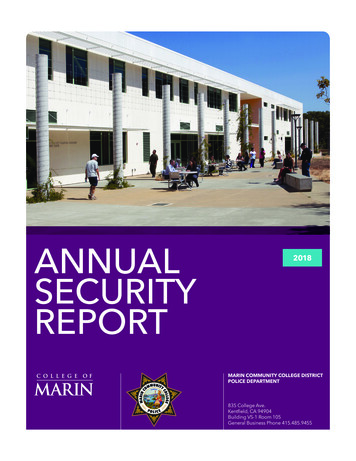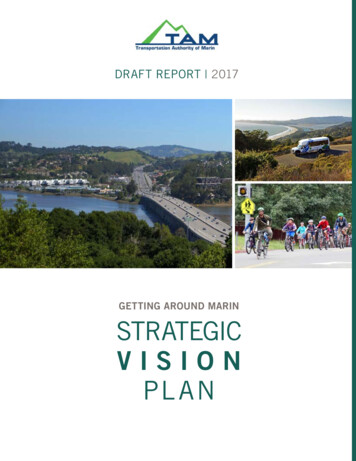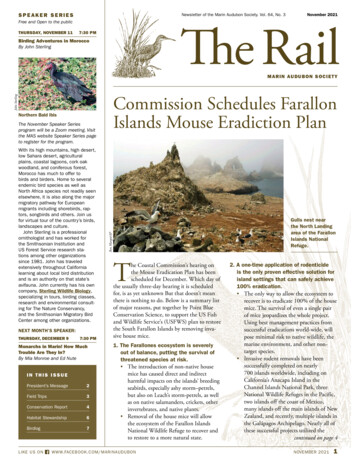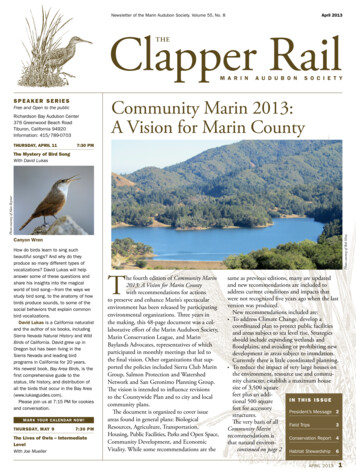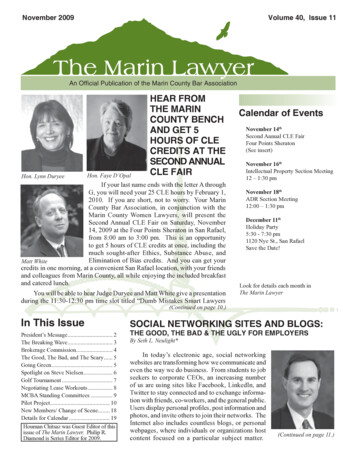
Transcription
November 2009Volume 40, Issue 11The Marin LawyerAn Official Publication of the Marin County Bar AssociationHon. Lynn DuryeeHon. Faye D’OpalHEAR FROMTHE MARINCOUNTY BENCHAND GET 5HOURS OF CLECREDITS AT THESECOND ANNUALCLE FAIRIf your last name ends with the letter A throughG, you will need your 25 CLE hours by February 1,2010. If you are short, not to worry. Your MarinCounty Bar Association, in conjunction with theMarin County Women Lawyers, will present theSecond Annual CLE Fair on Saturday, November14, 2009 at the Four Points Sheraton in San Rafael,from 8:00 am to 3:00 pm. This is an opportunityto get 5 hours of CLE credits at once, including themuch sought-after Ethics, Substance Abuse, andElimination of Bias credits. And you can get yourMatt Whitecredits in one morning, at a convenient San Rafael location, with your friendsand colleagues from Marin County, all while enjoying the included breakfastand catered lunch.You will be able to hear Judge Duryee and Matt White give a presentationduring the 11:30-12:30 pm time slot titled “Dumb Mistakes Smart LawyersCalendar of EventsNovember 14thSecond Annual CLE FairFour Points Sheraton(See insert)November 16thIntellectual Property Section Meeting12 – 1:30 pmNovember 18thADR Section Meeting12:00 – 1:30 pmDecember 11thHoliday Party5:30 - 7:30 pm1120 Nye St., San RafaelSave the Date!Look for details each month inThe Marin Lawyer(Continued on page 10.)In This IssuePresident’s Message. 2The Breaking Wave. 3Brokerage Commission. 4The Good, The Bad, and The Scary. 5Going Green. 5Spotlight on Steve Nielsen. 6Golf Tournament. 7Negotiating Lease Workouts. 8MCBA Standing Committees. 9Pilot Project. 10New Members/ Change of Scene. 18Details for Calendar. 19Houman Chitsaz was Guest Editor of thisissue of The Marin Lawyer. Philip R.Diamond is Series Editor for 2009.SOCIAL NETWORKING SITES AND BLOGS:The Good, The Bad & The Ugly For EmployersBy Seth L. Neulight*In today’s electronic age, social networkingwebsites are transforming how we communicate andeven the way we do business. From students to jobseekers to corporate CEOs, an increasing numberof us are using sites like Facebook, LinkedIn, andTwitter to stay connected and to exchange information with friends, co-workers, and the general public.Users display personal profiles, post information andphotos, and invite others to join their networks. TheInternet also includes countless blogs, or personalwebpages, where individuals or organizations hostcontent focused on a particular subject matter.(Continued on page 11.)1
The Marin LawyerPRESIDENT’SMESSAGEPRACTICING LAW IN ACIVIL MANNERBy Marlene P. GetchellRecently, I was involved ina hotly contested hearing in SanFrancisco Superior Court. As Ileft the courtroom following theproceeding, the opposing counsel (who shall remain nameless)followed me out of the courtroom, continuing to vigorouslyargue about the motion we had just argued before theCourt. He wouldn’t let me walk away, and literally “gotin my face” and continued arguing in a loud and abusivemanner until the bailiff, who had seen what was going onand followed us out of the courtroom, interrupted to askme if there was a problem.This incident was extreme in my 30 years of lawpractice, but hardly isolated. I frequently see other examples of lack of civility in the legal community. Bloggersare charging our judges with “undisputed lawbreakingactivity” and calling them names. Other bloggers whoappear to be attorneys continue to insult each other whileboth criticizing and defending our Courts.Maybe this simply reflects a problem that’s not confined to attorneys, but is also rampant in our society atlarge. Kanye West recently stormed onto the stage duringthe MTV Video Music Awards to complain that Beyonce’sSingle Ladies video should have won Best Female Video.Congressman Joe Wilson from South Carolina shouted out“you lie” during President Obama’s health care address toCongress. The list goes on and on.In a recent article published by The New York Times,author John Schwartz writes about attorneys reprimandedand fined for posting “intemperate” blogs about the courtand judicial process. In one instance, a Florida attorneyquestioned the motives and competency of a judge whoregularly gave defense attorneys only one week to preparefor trials, when most judges gave a month or more. TheFlorida attorney blogged about the judge, saying she wasan “Evil, Unfair Witch.” After reviewing briefs on FirstAmendment issues, the Florida State Supreme Court uphelda disciplinary agreement and the attorney paid a 1200fine. In another case described in The New York Timesarticle, a lawyer from Illinois lost her 19 year job in thePublic Defenders’ Office when she wrote posts to her blogin 2007 and 2008 that referred to one jurist as “Judge Clueless” and went on in other blogs to describe cases she hadworked on. In Southern California, an attorney receiveda 45-day suspension and was ordered to pay 14,000 in2legal fees because he failed to disclose he was an attorneyduring jury selection and he posted details of the case onhis blog during the trial.While rude and uncivilized behavior may be rampantin society as a whole, we attorneys, as counselors andsworn officers of the court, are properly held to a higherstandard. It is not just a matter of professional etiquetteor even common courtesy, although those are motivatingfactors for most attorneys. Our duties and obligations ofcivility are written into the law itself.There are many legal and ethical rules that set the standards for proper interaction between lawyers and judges.Rules governing professional courtesy and civility amongattorneys are really just common sense rules that shouldapply to individuals attempting to live in a civilized community. This article is not a legal dissertation about howfar an attorney can go in vigorously representing a clientbefore getting disciplined. It is about providing informationto assist the practitioner in reining in the kind of conductreferred to above while engaged in zealously representingand advocating the clients’ interests.In 1997, the MCBA’s Board of Directors adopted isown Code of Civility which is available on MCBA’s websitewww.mcba.com. MCBA’s Code of Civility is a commonsense approach to the practice of law and attempts to getrid of some of the childlike gamesmanship that sometimes(Continued on page 14.)“Providing Complete ADR Services!”JUDGE MICHAEL J. BERGER*JUDGE RICHARD H. BREINER*HON. JEANNE MARTIN BUCKLEY*JUDGE VICTOR M. CAMPILONGO*JUDGE JOHN J. GALLAGHER *JUDGE ISABELLA H. GRANT*JUDGE RON GREENBERG *JUDGE INA LEVIN GYEMANT*JUDGE HADDEN ROTH*JUDGE VERNON F. SMITH*PATRICK M.BRODERICKCLAYTON E. CLEMENTW. GREGORY ENGELHOWARD M. GARFIELDPERRY D. LITCHFIELDGARY T. RAGGHIANTIPAMELA M. SAYADMICHAEL D. SENNEFFSUSAN E. SPARMATTHEW N. WHITEW. BRUCE WOLDFamous RESREM LunchesLook for us on the Web-www.resolutionremedies.comValidated Parking–*RetiredDiane Levinson-Fass, Presidentfor more information callDiane Story, Vice President: (800) 778-2823
The Marin LawyerL-346333 D.qxp10/6/0910:19 AMPage 1THE BREAKINGWAVE:THE ABC’S OF FORECLOSURE LAWBy J. Timothy Nardell*In recent months, we havereceived an increasing numberof calls from both borrowersand lenders seeking advice ondefaulting loans. This trend,unfortunately, appears likely tocontinue. While the news of late has been full of talk of aneconomic recovery, the foreclosure crisis is still cresting.In mid-2006, approximately 55% of foreclosures were on“bottom tier” homes, and “top tier” homes accounted forbarely 18%. But by the middle of 2009, bottom tier homesaccounted for only about 35% of foreclosures, with top tierhomes accounting for approximately 30%. (ForeclosuresGrow in Housing Market’s Top Tiers, Wall Street JournalOnline, October 13, 2009.) This trend suggests that theforeclosure crisis has passed through the subprime marketand is catching up with more “mainstream” borrowers —like Marin county homeowners. We may not be able tohelp our neighbors in distress, but in times like these, weshould all know at least the ABC’s of foreclosure law.In California, a lender with a secured interest in realproperty has the right to pursue a loan in default throughprocesses of judicial or non-judicial foreclosure. Judicialforeclosure involves a court action, where the lender seeksa decree of foreclosure and order for sale. (Cal. Code Civ.Proc. §725a.) Following the foreclosure sale, the lendermay (subject to the anti-deficiency rules) obtain a judgment for any remaining debt. Non-judicial foreclosure isan accelerated remedy which allows the lender to obtainownership of its security without being subject to the costsand delay of the court process. Non-judicial foreclosuresare by far the favored remedy for lenders. However, theyare available only if a power of sale clause is contained inthe security instrument (which is almost universally thecase) and are subject to strict statutory rules. (See Cal. Civ.Code § 2924 et seq.) For lenders, non-judicial foreclosuresprovide a speedier process that avoids court action, and cutsoff any remaining right of redemption to the defaulting borrower after the foreclosure sale. Generally, three monthsafter a Notice of Default is filed, the foreclosing creditorcan record and disseminate a Notice of Sale with 20 daysnotice. This allows for a public auction of the propertywithin four months of filing the initial Notice of Default.The trade-off for this expediency is that no deficiencyjudgment is allowed after a non-judicial foreclosure, andany variance from the statutory requirements can nullifythe process.(Continued on page 14.)WORK SMARTERNOT HARDER.Intelligent California legal resources from West: Westlaw KeyCite Westlaw PeopleMap ProDoc Legal Calendaring West Case Notebook /West LiveNote The Witkin Library West LegalEdcenter Case Evaluator CFLR DissoMaster Suite Miller & Starr Library California Pleadings,Motions & Memoranda The Rutter GroupCalifornia Practice Guides For more information, call 1-800-762-5272. 2009 Thomson Reuters L-346333/10-09Thomson Reuters and the Kinesis logo are trademarks of Thomson Reuters.3
The Marin LawyerBROKERAGECOMMISSION –EARNED ATEXECUTION OFCONTRACT ORUPON CLOSING?diligence contingency and entering into sale contracts withprospective condominium purchasers but prior to receiptof temporary certificates of occupancy, Standard Pacificterminated its purchase agreement for the property basedupon substantial delays in the seller’s completion of theproject and deterioration of the market for condominiumsin Los Angeles. In conjunction with its termination of thepurchase agreement, Standard Pacific forfeited 4,000,000in earnest money and transaction costs. Standard PacificProper Drafting isrefused to pay any commission to RC Royal.ImperativeRC Royal filed an action for payment of its brokerageBy Scott D. Rogers* 2009commission alleging breach of contract and breach of theAnother recent California Court of Appeal decision implied covenant of good faith and fair dealing. The subunderscores the need for careful drafting of real estate stance of RC Royal’s complaint was that Standard Pacific’scontract documents. In RC Royal Development and Re- failure and refusal to consummate its purchase breachedalty Corporation v. Standard Pacific Corporation, 2009 both the agency agreement and the implied covenant. TheCal. App. LEXIS 1606 (September 29, 2009), the buyer trial court granted Standard Pacific’s motion for summary(“Standard Pacific”) was held liable for payment of a com- judgment finding that under the agency agreement RCmission to its broker (“RC Royal”) based upon its agency Royal’s brokerage commission would be payable onlyagreement with RC Royal notwithstanding that Standard when all contingencies had been removed and escrow actuhad justifiably terminated the purchase agreement. The ally closed. The trial court also held that Standard Pacific’scourt determined that the contract, as drafted, did not decision to terminate the purchase agreement was justifiedcondition payment of the brokerage commission upon and did not constitute a breach of the implied covenant ofclosing but instead was deemed earned upon execution of good faith and fair dealing.Analysisthe purchase agreement.The appellate court viewed the contract and circumBackgroundRC Royal contacted Standard Pacific regarding avail- stances very differently and read the agency agreementability of properties in downtown Los Angeles which RC more literally. In reversing the trial court’s determinationRoyal thought might be appropriate for development by that no commission was due, the appellate court focusedStandard Pacific. Standard Pacific entered into an agency on two specific provisions of the agency agreement. Theagreement with RC Royal pursuant to which RC Royal first specified that the commission would be payable “inwould be paid a 1.5 percent brokerage commission should the event the Property is purchased.” The second definedStandard Pacific purchase the property. The agency agree- “Purchase” as including any and all acquisitions of “any diment provided for payment of the commission through rect or indirect beneficial interest in the Property, including,without limitation, any lease, option, finance, exchange,escrow at closing.After its preliminary investigation of the property, stock purchase, joint venture or other transaction.”The appellate court found that once Standard PacificStandard Pacific executed a purchase agreement to acquirehadenteredinto the purchase agreement it acquired “eqthe property. The purchase contained many of the usualconditions including satisfaction of Standard Pacific’s due uitable title” to the property and consequently obtained adiligence review, issuance of certain entitlements and receipt “beneficial interest” in the property sufficient to triggerof temporary certificates of occupancy. After waiving its due Standard Pacific’s obligation to pay the agreed upon brokerage commission to RC Royal. The court rejected thecontention that close of escrow was a condition precedenthe obin RdmannRoup to payment of the brokerage commission holding that referReal Estate & Land Use Economic Consultants & Appraisersence to escrow was merely a description of the timing of thepayment. Its reasoning was that the contract definition of“Purchase” included several scenarios in which no escrow1885 Falcon Ridge DriveRobin J. eRdmann, maiwould exist at all (e.g., lease or stock purchase). The courtPetaluma,California94954PrincipalTelephone: (707) 766-8313specifically noted the absence of language indicating thatFax:(707) 766-8343escrow must close before the commission is earned.Robin Erdmann @ comcast.netThe appellate court also reversed the trial court’s findAppraisal/Evaluation & Review Market Feasibility Financial & Economic Analysising that Standard Pacific had not breached the implied dutyLitigation SupportStrategic PlanningCondemnation & Eminent Domainof good faith and fair dealing. The court noted that althoughRedevelopment & Economic Development AnalysisHighest & Best Use AnalysisTReG(Continued on page 15.)4
The Marin LawyerTHE GOOD, THE BAD, AND THESCARY:JUDGES EXPLAIN STATE OF THE MARINCOURTSBefore a capacity crowd of local lawyers and nearlyeach Marin County judicial officer, Judge Verna Adamsidentified some growing challenges for the Marin CountyCourts. The presentation took place at the Novembergeneral membership meeting of the Marin County BarAssociation, held at the Embassy Suites in San Rafael onOctober 28.Judge Adams, who will continue to serve as the Presiding Judge through 2010, noted the imminent retirementof Judge Michael B. Dufficy, who has served since 1990.Judge Dufficy’s replacement will be determined by anelection, but his position will probably not be filled in theinterim. Due to state budget cuts, it is also unlikely thatthe Judicial Council will assign a temporary judge to serveduring the vacancy. This leaves the courts one judge short.The civil department, which until recently had four judges,will be down to two.Other budget issues will further burden the dockets. Thestate government ordered the courts closed one Wednesdayeach month, which has already caused calendar disruption.Clerks, bailiffs, and reporters can no longer stay past 5 p.m.;the days of all-evening settlement conferences are no more.Judge Adams reported that she is reusing every scrap ofpaper, and not just for environmental reasons.Judge John Sutro, the presiding judge of the civildepartment, also addressed the membership. He thankedlawyers for their frequent volunteer service as judges protem and bench-bar settlement panelists.Judge Faye D’Opal, presiding judge of the family lawdepartment since the beginning of this year, emphasized theimportance of access to justice for everyone. She expressedgreat disappointment that the state government was limitingthat access by underfunding the courts.There was at least one bright note. Judge Lynn Duryee,presiding judge of the criminal courts, described a settlement program that has reduced the number of backloggedmisdemeanor cases by 75%. She attributed much of thissuccess to the hard work and cooperation of Deputy DistrictAttorney Leon Kousharian and Deputy Public DefenderGeorge Shea; she presented each with an “ExemplaryService in the Administration of Justice” award.Judge Adams noted that judges cannot defend themselves against criticisms involving pending cases. Shethanked the local bar for speaking up for the judges and insupport of an independent judiciary.Finally, the general membership approved the slate ofMCBA officers and incoming directors to serve with 2010President Beth Jordan: Otis Bruce, Jr., President-elect;Jessica Karner, Treasurer; Tim Chambers, Secretary; andLarry Baskin, five-year Past President. New Director slotswill be filled by Elizabeth Brekhus, Joel Gumbiner, RileyHurd, Lisa Maslow, and Randy Wallace.GOING GREENBy Kate Rockas, MCBA DirectorIncoming MCBA Director Lisa Maslow was recognized at the October 28, 2009, Judge’s Luncheon for obtaining Four Stars in the MCBA’s Green Star Program.Lisa has been practicing labor and employment lawsince 1983. After 15 years of defense litigation in SanFrancisco, she went solo with a home office in Mill Valley in 1998. Lisa’s primary practice consists of adviceand counseling to employers, helping them stay out ofcourt and effectively managing their employees. She alsoconducts independent workplace investigations of discrimination, harassment, and whistleblower complaints. Lisaoccasionally assists individuals in the review of severanceagreements and employment agreements.Lisa is married to Jonathan Rolnick, another labor andemployment law attorney who works in the San FranciscoCity Attorney’s office. Lisa and Jonathan have three children, ages 18, 12 and 10. Lisa enjoys attending the theaterand loves all kinds of music. She can be seen hiking thehills of Marin County, swimming laps at the Strawberry RecCenter pool, and at numerous school fundraising events.Lisa has incorporated green practices in her home andoffice for many years. In her office, she uses recycled paperproducts and refilled cartridge toners. Her primary methodof communication is by email. She has been archiving clientemails for the past ten years. Lisa has very minimal paperfiles for her clients and recycles most of that paper when it istime to discard the file. Lisa prints on both sides of paper anduses JFAX to receive electronic versions of incoming faxes.All client invoices are sent by email and most online researchis never printed on paper. Lisa doesn’t heat her office – shewears extra sweaters and drinks hot tea to stay warm.In her home, Lisa and her family use stainless steelwater bottles and recycle paper, glass and plastic. Theyuse Energy Star appliances, an electric lawn mower, andrecently installed carpet floor tiles made of recycled material. Her husband and younger daughter have a vegetablegarden and just started composting.Congratulations on the Four Stars, Lisa! Many thanksto you and your family for your green contributions to ourcounty.The Bay Area’s Premier Reporting Service ComplimentaryConference Rooms Document Depository Livenote/E-Transcript VideoconferencingCapturing your wordswith caring hands.800-979-2361117 Paul Drive, Suite ASan Rafael, CA 94903415-472-2361 · Fax 415-472-2371depos@westcoastreporters.com5
The Marin LawyerMEET YOURDIRECTORSSPOTLIGHT ON STEVENIELSENThe Marin Lawyer decidedthat it would be a good idea tolet the MCBA membership getto know a little more about theMCBA Directors whom theyelected, and who give so muchto make the MCBA a great, vibrant, organization. To thatend, The Marin Lawyer ran a series of articles, each focusing on a different MCBA Director or Officer. Having now“spotlighted” all current Directors and Officers, this month,our spotlight is on MCBA Intellectual Property SectionChair Steve Nielsen.The Marin Lawyer: What is your practice area?Steve Nielsen: I focus on the procurement of patentsbefore the United States Patent & Trademark office andpatent litigation in federal court.TML: Do you have any particular emphasis?SN: I work on obtaining all types of patents, withthe exception of stem cell projects and complex biologycases. But, I have litigated all types of patents, includingcervical cancer detection methods, and cancer cell stainingand medical devices. I try to stay out of biology labs asthe smell and filth turn my stomach. On the other hand,optical, electrical and mechanical environments are usuallyclean and orderly.TML: Why did you decide to become a lawyer?SN: I grew up in Placerville where the only culturewas agriculture and commercial logging was the mainindustry. In high school I worked for a logging companysetting chokers (large steel cables) around fallen trees. Iwould hook the cables to a bull dozer, which would plowover small trees while dragging the logs miles away to aloading area. The logs would kick up all kinds of debrisand some plowed trees would snap back and propel pinecones and branches in unpredictable directions. Many ofmy co-workers lived in tents on the job sites and might havebeen able to field one full set of teeth as a group. While Ienjoyed the smell of the outdoors and fresh cut trees, thiswas not an appealing career choice.At age 10, I observed my father, who at age 40 startedattending night classes at McGeorge Law School in Sacramento. He and three friends drove to Sacramento (60miles each way) 2 to 3 nights a week for four years. All6four passed the bar and enjoyed successful law practices.While growing up, I enjoyed hearing about law school andthe various cases that my father would take on. The firstclients would come to our home to meet with my father. Irecall my mother vigorously cleaning the bathroom aftereach client visit. My father eventually secured a law officeon Main Street next to the court house. I enjoyed watchingseveral of his trials and later enjoyed his political exploitsas a two term county supervisor of El Dorado County.Just prior to retirement, my father worked for two yearsas the Chief Executive Officer for the El Dorado Countycourt system. Seeing my father start out with nothing anddevelop a successful law practice and political career wasvery inspiring.TML: How did you decide to become a patent lawyer?SN: I have always enjoyed math and science. I mighthave become an electrical engineer if I had known of sucha profession while growing up. I don’t recall any “careerdays” in Placerville and there was no real exposure tocareers outside of our community. Our public schools hadtheir hands full just trying to teach us to read and write.Thus, I went to college and law school, and took a local jobnear Berkeley where I could try cases. I enjoyed 10 years oftrying all types of cases in state courts and gravitated towarddefending older civil and structural engineers in construction cases and young dentists who were working at various(Continued on page 16.)Green MediationSMADR NeutralsOver 58 years combined legal experienceClean up and resolve your case. We have formalmediation training and have served as advocates in dozensof mediations, settled successfully. As litigators, we knowhow to settle creatively, get parties to think outside the boxand to narrow the issues. Our International experience is anasset to any case. Business & Contract disputesCorporations, LLC, LLP and Partnership disputesIntellectual Property disputesEntertainment & media mattersEstate disputesEmployment mattersReal Estate contracts, neighbor disputesConstruction disputesBeverly & Phil GreenCourthouse Square1000 4th Street, Suite 595San Rafael, Cal 94901(415) 457-8300www.greensmed.com
The Marin LawyerTHIRD ANNUALMCBA GOLFTOURNAMENTA SUCCESSThe Third AnnualMCBA Golf Tournamentbuilt on the momentum ofthe first two years and wasa great success. Held onJoel Gumbiner and Larry BaskinOctober 2, 2009, at theprepare to tee off for 1 million.beautiful San GeronimoGolf Course, the eventwas once again coordinated by MCBA Ad Hoc Golf Committee Co-chairs (and Board Members) Lou Franecke andPhil Diamond. As past participants will recall, the first year’sevent had to be postponed one week at the last minute due torain. Although the weather cooperated for this year’s event(warm and sunny, and almost no wind), in the immortalwords of Gilda Radner’s Rosanne Rosannadanna, “If it’snot one thing, it’s the other thing.” This time the event wasoriginally scheduled to be played at the renovated PeacockGap golf course because the greens at San Geronimo werescheduled to be aerated (and therefore virtually unplayable)during the time period we wanted, whereas that was notgoing to be a problem at Peacock. However, as luck wouldhave it, about two weeks before our tournament, Peacock’sgroundskeeper changed his aeration schedule such that thegreens were going to be aerated one day before our event!Fortunately, San Geronimo’s greens had sufficiently recovered by that time and the course was able to take ourtournament back at the last minute, at the same date andtime originally scheduled for Peacock. Peacock returnedour deposit, all golfers were notified of the change of location, and the tournament went off as planned. Our golfersare nothing if not flexible!!The tournament was developed to promote camaraderie among MCBA members and to raise funds for a chosencharity, which was again Guide Dogs for the Blind (whichis headquartered in San Rafael). Six foursomes participatedthis year (down slightly from last year, but given the economyand in comparison with how other fund-raising tournamentshave fared, not a bad showing at all), and over 1,300 wasraised for Guide Dogs from entry fees, sales of tickets for“mulligans” (which are “do-overs” for you non-golfers) andentry into the post-round raffle, and sponsorships.As before, the tournament was held in a “scramble”format with a simultaneous “shotgun” start by all golferson different holes, with each foursome competing as a teamfor the low score. In this format, all golfers, regardless ofability, had an opportunity not only to participate but alsoto be a “hero” to his or her foursome.After the rounds were completed, participants gatheredin the San Geronimo Clubhouse for drinks and the presentation of awards for First, Second, and Third Place team score,Long Drive, and Closest to the Hole. First place went toJoel Gumbiner, Lou Franecke, Steve Ruben, and Mohinder Mann; second place went to Greg Dyer, Joe Legallet,Ira Hillyer, and Richard Nelson; third place went to RayCherry, Larry Levin, T.J. Raseal, and Steve Blackman.The Longest Drive award went to Derek Weller, andthe Closest to the Hole award (given to the golfer whosetee shot on a designated par-three hole landed closest tothe hole) went to Larry Baskin.Like last year, the tournament also included a postround “1,000,000 Hole In One Challenge,” which wassponsored this year by Tamalpais Bank. The Challengeconsisted of the golfers with the two closest-to-the-holetee shots attempting to win one million dollars by hitting ahole in one from a distance of 165 yards. The participantswere Joel Gumbiner and Larry Baskin. Although Joel andLarry both gave a great effort, regretfully neither actuallygot the ball into the hole.New to this year’s event was an additional hole-in-oneprize – a 2010 Toyota Prius parked next to the tee box, graciously provided by Toyota Marin, which would be awardedto the first player to hit a hole-in-one on the designated Par3 hole. Unfortunately, no one actually “holed out” in oneshot, and the Prius went unclaimed.MCBA would like to thank all of the participants whogave up an afternoon in the office for the event. MCBA wouldalso like to thank Tamalpais Bank (which not only sponsoredthe “ 1,000,000 Hole In One Challenge” but also donated asubstantial sum to the event), West Coast Reporters, and Izzy’sRestaurant for their generous sponsorship support.The MCBA Golf Tournament once again achieved itsdual objectives of community-building and fund-raising,and there is no question that the word “Annual” will remainin its name. Join us next year, at MCBA’s Fourth AnnualGolf Tournament!A. MAGGI SAUNDERS & ASSOCIATESC ER TIFIED SHO R THAN D R EPO R TER SSer ving the E ntire B ay Area s inc e 197 4415-383-6281 (office)415-823-3790 (mobile)maggisaunderscsr@neteze.com“In a deposition, the Court Reporteris your biggest asset”Lowest Per Page Rate - Delivered in One WeekNo Premium rates for Doctors, Expert Testimony,Evening or Weekend DepositionsFree Condensed transcripts, ASCIIs, CDs,Translators, Video Depositions, Free Conference RoomMember: National
Westlaw KeyCite Westlaw PeopleMap ProDoc Legal Calendaring West Case Notebook / West LiveNote The Witkin Library West LegalEdcenter Case Evaluator CFLR DissoMaster Suite Miller & Starr Library California Pleadings, Motions & Memoranda The Rutter Group California Practice Guides .



